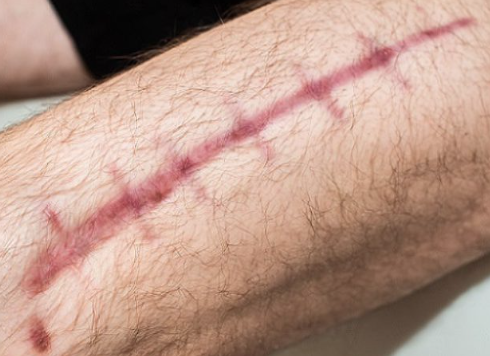An Often Overlooked Limited Tort Exceptions: Disfigurement.
 A motorist or passenger in Pennsylvania bound by the “limited tort” election can only sue for economic loss, not pain and suffering, unless certain exceptions (such as drunk driving) apply. The most common exception is when the injury causes a serious impairment of an important bodily function. Other exceptions include injuries as a pedestrian, or when riding a bike or motorcycle. But there is one often overlooked exception: permanent disfigurement.
A motorist or passenger in Pennsylvania bound by the “limited tort” election can only sue for economic loss, not pain and suffering, unless certain exceptions (such as drunk driving) apply. The most common exception is when the injury causes a serious impairment of an important bodily function. Other exceptions include injuries as a pedestrian, or when riding a bike or motorcycle. But there is one often overlooked exception: permanent disfigurement.
Permanent and Serious Disfigurement
The standard to prove the “disfigurement exception” to limited tort sounds daunting and exceedingly high. After all, it requires proof of a serious and permanent change to one’s appearance. Because of this, plaintiffs may feel hesitant to bring such a claim. Likewise, defense counsel — defending a case brought by a limited-tort-plaintiff — may feel optimistic about challenging and getting dismissed the “disfigurement exception” claim, prior to trial. A dismissal before trial can happen. However, it’s certainly not guaranteed, as the Defendant learned in WALDINGER v. WOKULICH, No. 478 WDA 2022 (Pa. Super. Ct. Feb. 15, 2023).
Questions Of Fact For a Jury
 In WALDINGER v. WOKULICH, No. 478 WDA 2022 (Pa. Super. Ct. Feb. 15, 2023), the limited tort plaintiff was injured in a motor vehicle accident, causing her need for surgery. Plaintiff relied on the “serious disfigurement” exception for her surgical scar. The defendant filed a motion for summary judgment, claiming the scar was “only” two inches long. Secondly, Plaintiff had failed to consult with a doctor about scar revision or whether the scar would be permanent. Third, the defense claimed the scar was not “serious” because no evidence existed that the scar interfered with Plaintiff’s life, as Plaintiff admitted it was only “sort of” embarrassing. The trial court agreed with the defendant and dismissed the case.
In WALDINGER v. WOKULICH, No. 478 WDA 2022 (Pa. Super. Ct. Feb. 15, 2023), the limited tort plaintiff was injured in a motor vehicle accident, causing her need for surgery. Plaintiff relied on the “serious disfigurement” exception for her surgical scar. The defendant filed a motion for summary judgment, claiming the scar was “only” two inches long. Secondly, Plaintiff had failed to consult with a doctor about scar revision or whether the scar would be permanent. Third, the defense claimed the scar was not “serious” because no evidence existed that the scar interfered with Plaintiff’s life, as Plaintiff admitted it was only “sort of” embarrassing. The trial court agreed with the defendant and dismissed the case.
However, the Plaintiff appealed.
Superior Court Hears Appeal by Plaintiff
First, the Superior court noted the correct standard to apply in “disfigurement exception” cases, as follows:
…a “serious permanent disfigurement” requires that one’s appearance, form or beauty be affected or marred in a displeasing, harmful way which is significant and not minor and will not change, go away or be diminished. We recognize that such a determination can be very subjective. Consequently, taking from Washington, we set forth a similar inquiry to apply.
What disfigurement, if any, resulted from the motor vehicle accident?
Was the disfigurement permanent?
Was the disfigurement serious? In determining whether the disfigurement is serious, several factors should be considered: appearance, obviousness, size, shape, symmetry, coloration, and any other relevant factors.
Applying the foregoing here, we first observe that the particular disfigurement at issue is a scar. As noted above, a scar in and of itself is disfiguring. Nevertheless, we recognize that not every scar is permanent or serious.
As for the permanency of the scar, the court noted that four years had passed since the accident. However, the scar remained unchanged. Further, it is not necessary to prove permanency of the scar through expert medical evidence. A fact finder may “determine from his own observations whether the disfigurement is permanent,” citing EPurex Corp. v. Workmen’s Comp. Appeal Bd., 445 A.2d 267, 269 (Pa. Commwlth. 1982), abrogated by Hastings, 611 A.2d at 1187.
Evaluating Whether a Scar Is “Serious”
The “appearance” of a scar is subjective. Where “reasonable minds could differ,” the issue must go to a jury. For this reason, a judge should err on the side of letting a jury decide whether a scar is “serious.” However, there is one thing we can say objectively on this subject: you don’t focus on whether the scar had a “serious” effect on the Plaintiff’s life. In WALDINGER, the superior court noted:
In granting summary judgment, the trial court .. focused on the impact Waldinger’s scar had on her life. Unlike the serious impairment of body function analysis, this is not the appropriate inquiry. Certainly, the impact a disfigurement has on an individual, such as whether it is embarrassing or creates self-esteem issues is relevant but, it is not the primary factor. Instead, the inquiry is the effect on the person’s appearance.
…
When viewing the evidence in the light most favorable to Waldinger, we conclude that reasonable minds could differ as to whether her scar constitutes a serious permanent disfigurement. . . We therefore reverse the court’s order granting summary judgment on her claims for non-economic damages.
And just like that, the Defendant’s challenge to a limited tort claim had failed.
What Plaintiffs and Their Attorneys Can Learn From Waldinger
First of all, Waldinger was a non-precedential decision, meaning it’s not binding on future cases. That said, the reasoning can be used persuasively in future cases. The bottom line is, many injuries leave scars. Nearly every surgery — or surgical procedure — can disfigure the patient, to some extent. For example, a surgery done arthroscopically — without “cutting a person open” — will leave a scar. Even a procedure to inflate a collapsed lung — involving a small puncture — may leave a permanent mark. For each of these, “reasonable minds may differ” as to whether each of these constitutes a “serious” and “permanent” injury.
Thus, it will often be a question for a jury to decide, and not a case to be dismissed on summary judgment. Therefore, any person bound by a limited tort for his motor vehicle injury should consider bringing a “serious disfigurement” claim, if warranted, no matter how daunting the standard may appear.
Let’s Get Started!
Contact a Pittsburgh attorney at our firm for a free consultation any time about any motor vehicle accident claim!
412.342.0992
